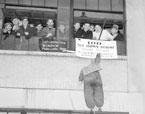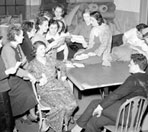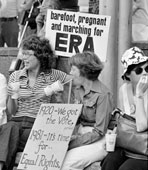
Gender and the Automobile in the United States
Gender on the Line
Women were involved in producing automobiles as well as consuming these popular twentieth-century vehicles. Historians have written many volumes on male car workers, their response to Fordism and Sloanism, their union struggles in the 1930s, their position as well-paid and organized blue-collar workers in the post-war years, and their struggles to adjust to restructuring as the automobile industry faced foreign competition and environmental criticism, and adopted automation. Only recently have historians and social scientists examined female car workers in an attempt to recover the hidden past of how women specifically contributed to manufacturing automobiles and thereby to industrial relations. Their findings reveal that women’s access to auto factory work opened slowly and with difficulty. Male blue-collar workers, long persuaded by the ideal of the family wage, resented female intrusion into their workspace and created barriers to gendering work patterns despite the egalitarian ethos of industrial unionism.
Women have always been part of the American automobile labor force, but they became more visible during the union struggles of the 1930s. As very supportive auxiliaries during the major sit-down strikes of 1936-37 they contributed indirectly to the building of the United Auto Workers (UAW) in these critical years. They were also more directly active in the drive towards organizing industrial unionism in parts plants, like the Ternstedt General Motors factory in Detroit or at Fry Products, also in Detroit, where women were numerous. Conventional ideas about women’s place being in the home, however, prevented any sustained action by female auto unionists to press for gender equality, let alone consideration of women’s special needs. Males, whether rank and file workers or union leaders, were insensitive to feminine needs and concerns. The mass assembly line was a masculine domain, or in the words of Nancy Gabin a “No Woman’s Land.”
American participation in World War II initiated changes in the position of female workers as over six million American women responded to male labor shortages and became the nation’s reserve army of labor. In the auto industry the number of female workers jumped from 28,300 in October 1941 to 203,300 in November 1943, and by 1945 women comprised 28% of the UAW’s membership of one million. Women then took advantage of their stronger numerical position to express their concerns about gendered working conditions. They challenged aspects of the sexual division of labor that defined female and male work as separate and unequal and confined women to a limited number of poorly paid jobs. They made some path-breaking gains. The UAW responded positively, albeit at times grudgingly. It supported the federal government’s wartime funding of day-care facilities for children of working mothers, developed a model maternity rights clause for inclusion in work contracts, introduced a much-admired scheme of counselling for new female workers, assisted the progress of experienced women up the ranks of local union leadership, and established the Women’s Bureau as an Office of the War Policy Division in 1944. Unfortunately, the support the UAW gave to improving female auto workers’ needs proved to be only temporary. The wartime reclassification of jobs and the retention of male wage rates and seniority rights had already suggested that any gains might be short-term and that women would be expected to revert back to low-paid inferior jobs or preferably to domesticity. And when male workers returned to the auto industry in 1945, they insisted on the long-established structure and organization of work.
Traditionally historians have discussed American women’s labor experience in the post-war years as being in the doldrums. Female workers were perceived to lose ground as the culture of domesticity flourished. Not until the feminist activism of the 1960s would issues of gender equality and women’s dual responsibilities at home and at work be publicly debated. Revisionist historians have, however, now clearly demonstrated that modern feminism neither born in the 1960s, nor was solely led by discontented white middle-class women. Working-class feminism emerged from union halls and factory floors in the 1930s, grew during the war, and developed a new consciousness in the two decades after the war. Then women entered the long struggle for workplace justice and social rights, and they argued for the dismantling of the masculine standard. These labor reformers initially wanted sexual equality on the shop floor. But they gradually came to argue for both full equality and special benefits for women and did not consider that the two concerns were incompatible. They were building a case that gender differences must be accommodated and that equality has not always been realized by applying the same standards of behavior to women and men.
In this more persuasive approach to the labor feminists of the post-Depression years, women on the automobile lines and in the UAW were leaders in the struggle to achieve workplace equity. Their wartime experiences left a positive rather than a negative legacy in providing both a sense of self-confidence and an appreciation that work conditions were not unchangeable. Certainly in the late 1940s the number of female auto workers was reduced, often by discriminatory tactics, and the UAW frequently failed to defend its female membership. Although frustrated by indifference and at times hostility even from their male counterparts, female activists and staff in the Women’s Bureau continued to challenge the union to retain its commitment to fully equal treatment, and they persisted in engaging with the problem of occupational segregation and in making gender-conscious protests. Gradually, if grudgingly, increasing numbers of auto unionists in the 1950s and early 1960s found the arguments for equal job rights, including the claims of married women, more persuasive. The debate over a single seniority list rather than separate male and female lists further indicated a growing awareness of workplace justice among auto workers. These were the good years for workers in auto plants as the UAW, nearing the peak of its influence and power in the industry, negotiated job security, rising wages, and fringe benefits for its members.
Women in the auto industry, who could be regarded as leaders in labor women’s rights in these years, subsequently became involved in the famous legal battles of the liberal years over equal pay and civil rights. They fully supported the need to address the race issue through civil rights legislation, and when Title VII, or the sex clause, was added to the Civil Rights Act of 1964, many pressed union officers to challenge management’s discriminatory practices of applying older state laws on such issues as overtime and long-hours shifts that prevented women from gaining access to better-paid jobs. Here the UAW women’s officials were at odds with other labor women who represented female-dominated workers in less well-paid industries and with some of their own members. But they persisted in pressing for gender equality even though this meant accepting the male standard in hours as well as wages. Subsequently in 1970, the UAW endorsed the Equal Rights Amendment (ERA), the first union to do so. More tensions followed with other union women as they debated how to move forward in the interests of women, but UAW leaders insisted on sex-blind treatment in the workplace and promoted greater activism among union women. They knew that culturally women remained dissimilar to men because they bore the burden of household work and childcare, but they failed to promote the equal sharing of these domestic responsibilities. Their feminism was thus limited by its narrow focus, which is as problematic now as it was then.
Yet in the 1960s and early 1970s the working-class activism that emerged from the female auto workers was transforming in terms of raising issues of gender equality and social justice. It occurred, however, shortly before the industry faced major restructuring as a result of international competition, the flight of American production abroad, outsourcing, new labor-saving technologies, and new patterns of work organization. The industry that employed one million workers in 1978 slumped to some 750,000 five years later. Women were among the many who lost their jobs as plants were closed or modernized. Although union activists continued to support women’s efforts to increase their incomes by seeking access to men’s auto jobs and also moved in the direction of comparable worth to help those women who still remained in the lower-paying female jobs, they faced major problems of unemployment. Thousands of women were laid off or were bought out of their contracts and conceded wage rates, benefits, and work rules won in the prosperous years. The UAW, like other older industrial unions, was in a weak position to negotiate improvements as blue-collar manufacturing jobs declined and power shifted from labor to management in the 1980s despite the introduction of some Japanese management practices. Workers of both sexes faced humiliations of daily shop-floor life, and women not only had to struggle with this poor supervisory treatment, but also faced resentment from their co-workers. They had become a cog in a dehumanized production line.
<<Previous Section - Next Section>>
Placing Gender and Automobiles into Perspective
Gender and Automobility: The Pioneering and Early Years
Gender and Automobility: Consumerism and the Great Economic Boom
Gender and Automobility: Sexual Equality in Modern Times
Gender on the Line
For more on workers' responses to Fordism and Sloanism, see Stephen Meyer's "Labor Under Mass Production" and "The Rise of Sloanism."
About the Project | Credits | Contact Us | Student & Teacher Resources | Site Map
©2004 Automobile in American Life and Society


